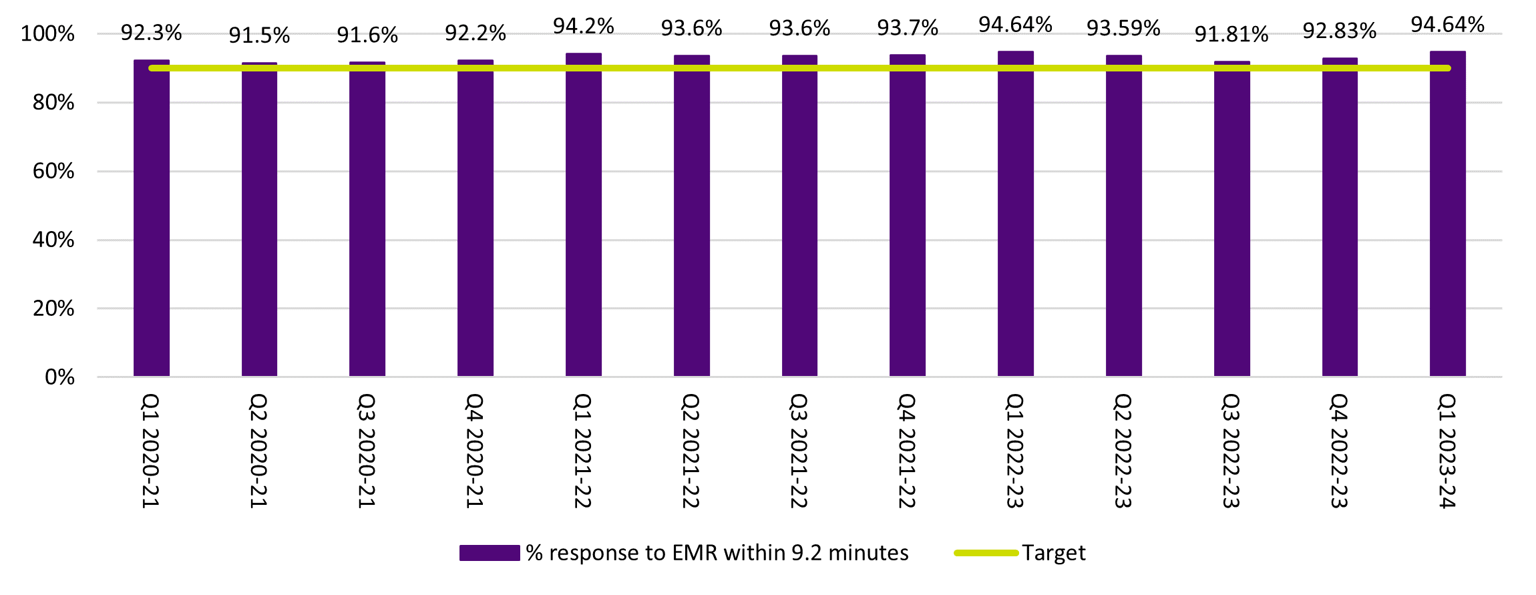2.1.1 FRV emergency medical response (EMR)
FRV continues to achieve its target for percentage of response to EMR within 9.2 minutes (measure 2.1.3a) in FRV districts. FRV reported a result of 94.64 per cent and has met the target of 90 per cent over 13 consecutive quarters, which is a good result for the community (see Figure 1). FSIM notes that FRV recorded 1511 EMR incidents in FRV districts (measure 1.3.1).
FRV advise that the following factors have contributed to this result:
- collaboration with Ambulance Victoria in delivering firefighter EMR training and co-responding to EMR calls
- having EMR qualified firefighters responding to relevant calls on EMR capable appliances and
- introducing standardised EMR capabilities and oxygen resuscitation equipment across the fleet.
Data note
Prior to the December 2022 cyber-attack, FRV reported this measure by sourcing data from AIRS. FRV has used data obtained from the ESTA CAD system to report this quarter’s result. FRV report that the ESTA CAD data has been validated to ensure its integrity and comparability. FRV advised FSIM that their comparative analysis confirmed that the difference between the two data sets (using ESTA CAD data instead of AIRS data) did not materially affect results.
Figure 1 includes results reported using AIRS data for results between Q1 2020-21 to Q1 2022-23 and ESTA CAD data for results reported between Q2 2022-23 to Q1 2023-24.
Note re figure 1: Quarterly year-on-year baseline were introduced from Q2 2022-23. As reported in the Fire Services Outcomes Report Q2 2022-23, CFA has not calculated baselines retrospectively for results recorded prior to Q2 2022-23.
2.1.2 CFA decrease in workplace injuries
CFA reported 26 workplace injuries in Q1 2023-24 (indicator 3.1.2). This is well below the CFA quarterly baseline of 70 and a positive result for CFA volunteers and staff (see Figure 2).
CFA advise that contributing factors to the reduction in workplace injuries may include:
- work undertaken by CFA Health and Safety advisors to improve brigade health and safety awareness
- CFA hazard inspections at fire stations which aim to mitigate potential hazards and minimise risk of injury on site
- Health and Safety committees established by CFA for staff and volunteers, placing a spotlight on health and safety within CFA.
FSIM also notes that CFA continued to record an increase in hazard reporting (indicator 3.1.1) on its CFASafe system, as required under its legislation, reporting 89 this quarter, compared to 85 in Q4 2022-23 and 81 in Q3 2022-23.
Hazard reporting is used to identify hazards to mitigate risk against injuries. If a hazard is reported at a brigade (via CFASafe), CFA advise that this may prompt a hazard inspection outside those undertaken as part of the section 29 process. Action plans to respond to hazards (and incidents/near misses) are tracked in CFASafe.
FSIM notes that this positive hazard reporting trend may also be contributing to a reduction in workplace injuries at the CFA.
Note re figure 2: Quarterly year-on-year baseline were introduced from Q2 2022-23. As reported in the Fire Services Outcomes Report Q2 2022-23, CFA has not calculated baselines retrospectively for results recorded prior to Q2 2022-23.
2.1.3 CFA smoke alarm installation and maintenance
CFA reported 360 smoke alarm installation and maintenance activities for vulnerable people who require assistance (indicator 2.3.6). This is an increase of 200 on the CFA quarterly baseline this quarter, and the second consecutive quarter the CFA has significantly exceeded their baseline; the Q4 2022-23 result exceeded the baseline by 356 (see Figure 3).
CFA report that smoke alarm installation is part of a suite of CFA home fire safety activities scheduled in the winter period. CFA work with local councils and community networks to reach households at risk. CFA report that a significant percentage of homes engaged had inoperable smoke alarms.
FSIM notes that CFA have completed 72 per cent of their target to achieve 500 smoke alarm installation and maintenance activities for 2023-24.
Updated


